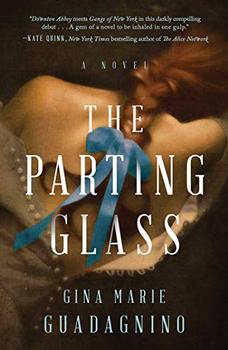Summary | Excerpt | Reading Guide | Reviews | Beyond the Book | Read-Alikes | Genres & Themes | Author Bio

This article relates to The Parting Glass
 In the historical novel The Parting Glass, narrator Mary Ballard's twin brother becomes involved with a notorious secret society/street gang in New York City called the Order. Mary's friend Liddie recalls meeting her brother during a night of rioting that seems to have been based on the Dead Rabbits riot, which took place July 4-5, 1857, so-named for one of the gangs that took part in the mayhem.
In the historical novel The Parting Glass, narrator Mary Ballard's twin brother becomes involved with a notorious secret society/street gang in New York City called the Order. Mary's friend Liddie recalls meeting her brother during a night of rioting that seems to have been based on the Dead Rabbits riot, which took place July 4-5, 1857, so-named for one of the gangs that took part in the mayhem.
The Dead Rabbits was one of the most notorious Irish gangs in New York City in the mid-19th century. The unusual name is said to reference a gang meeting in which one member threw a dead rabbit into the center of the room, which some people present viewed as an inauspicious omen. Their gang symbol featured a dead rabbit on a pike. The Dead Rabbits was made up predominantly of Irish immigrants (who fled the potato famine in their home country) living in and near Five Points, an area in downtown Manhattan named for the convergence of five streets (now part of Chinatown). Five Points was filled with tenements housing immigrants, the impoverished, and the formerly enslaved. The Dead Rabbits were known for robbery and for their blood feud with the rival gang the Bowery Boys, anti-Catholic, anti-Irish nativists and volunteer firemen. In the latter capacity, they were known to fight other fire companies over who would have the privilege of extinguishing a blaze. Furthermore, rival gangs took advantage of the Bowery Boys' day jobs by setting fires, and then attacking when the Boys showed up to put them out.
Both gangs attempted to lay claims to Five Points, and this dispute culminated in the fourth of July riot. The clash began when a large group of Dead Rabbits entered the Bowery (a neighborhood in southern Manhattan) with a plan to raid the Bowery Boys' clubhouse. The two gangs clashed outside the building and the Dead Rabbits were driven back into Five Points. Police failed to intervene, and the fighting continued into the next morning when the Dead Rabbits returned to the Bowery and attacked a Bowery Boys' hangout called the Green Dragon. The Bowery Boys onsite called in reinforcements, and a massive melee ensued, with an estimated 1,000 gang members taking part. The fighting continued into the evening until police convinced Tammany Hall political organizer and gang associate Captain Isaiah Rynders to try to negotiate a truce. Rynders failed and suggested the police call in the state militia to take control of the situation.
The militia managed to quell the riot, which killed at least eight and injured somewhere between 30-100. Tensions in Five Points cooled in the years following as the Bowery Boys opted to stay out of the Dead Rabbits' territory. This rivalry was represented (in fictionalized form) in Martin Scorsese's 2002 film Gangs of New York.
America was awash in anti-Irish sentiment in the 19th century, as evidenced by the Bowery Boys nativism, and the discrimination that resulted from these sentiments surely drove many ordinary Irishmen into a life of crime, as it did Mary Ballard's brother in The Parting Glass. Immigrants fled the famine in Ireland hoping for an opportunity at a better life, only to find themselves living in tenements and often unable to find employment. With little chance at a respectable livelihood, gangs like the Dead Rabbits probably looked very appealing.
View of fight between two gangs, the "Dead Rabbits" and the "Bowery Boys" in the Sixth Ward, New York City.
Filed under People, Eras & Events
![]() This "beyond the book article" relates to The Parting Glass. It originally ran in May 2019 and has been updated for the
April 2020 paperback edition.
Go to magazine.
This "beyond the book article" relates to The Parting Glass. It originally ran in May 2019 and has been updated for the
April 2020 paperback edition.
Go to magazine.
Your guide toexceptional books
BookBrowse seeks out and recommends the best in contemporary fiction and nonfiction—books that not only engage and entertain but also deepen our understanding of ourselves and the world around us.